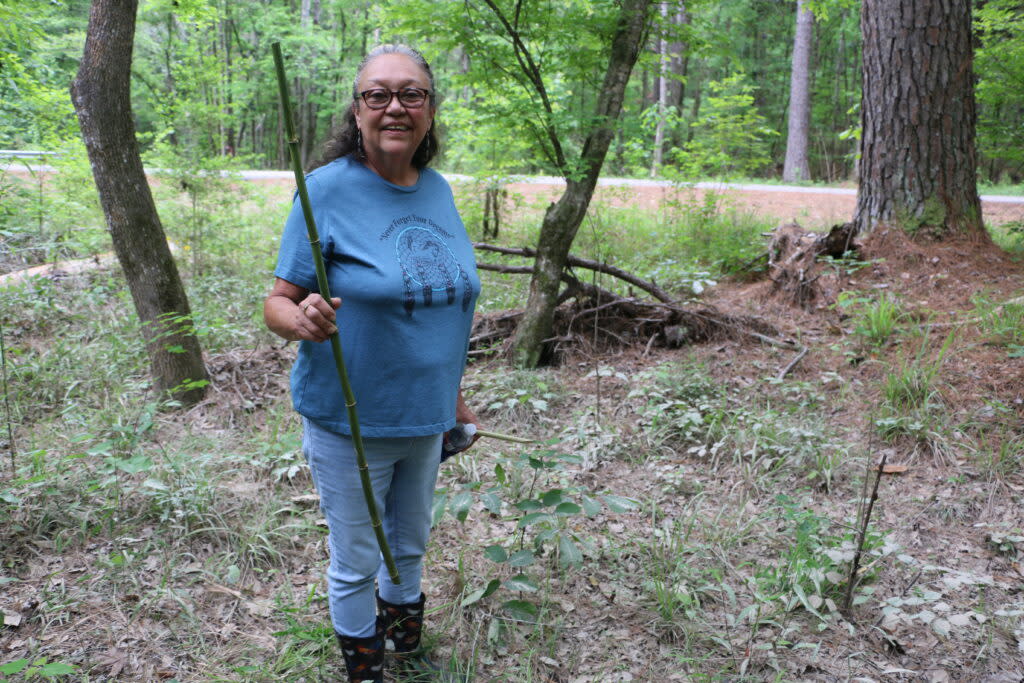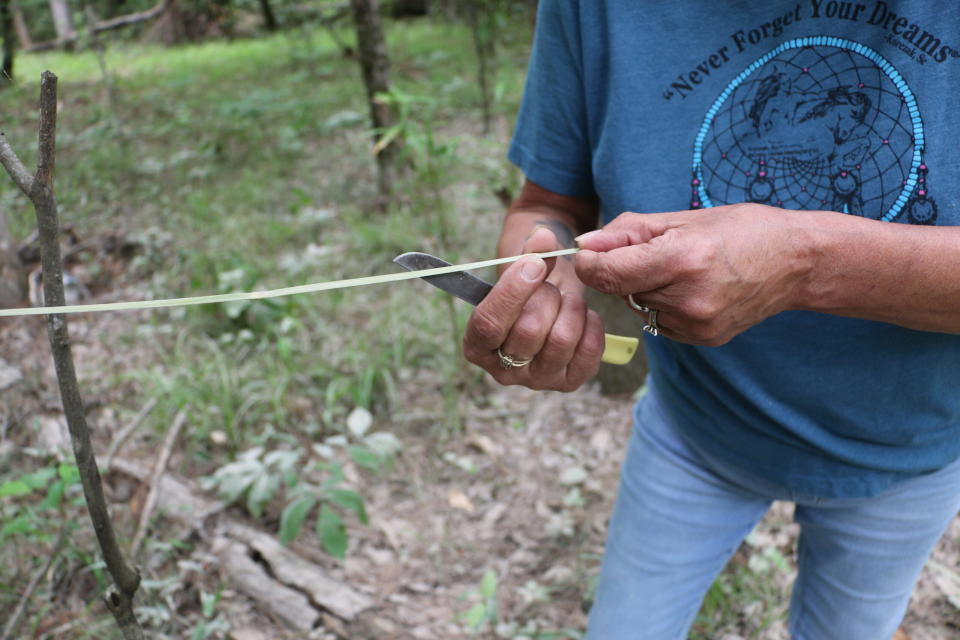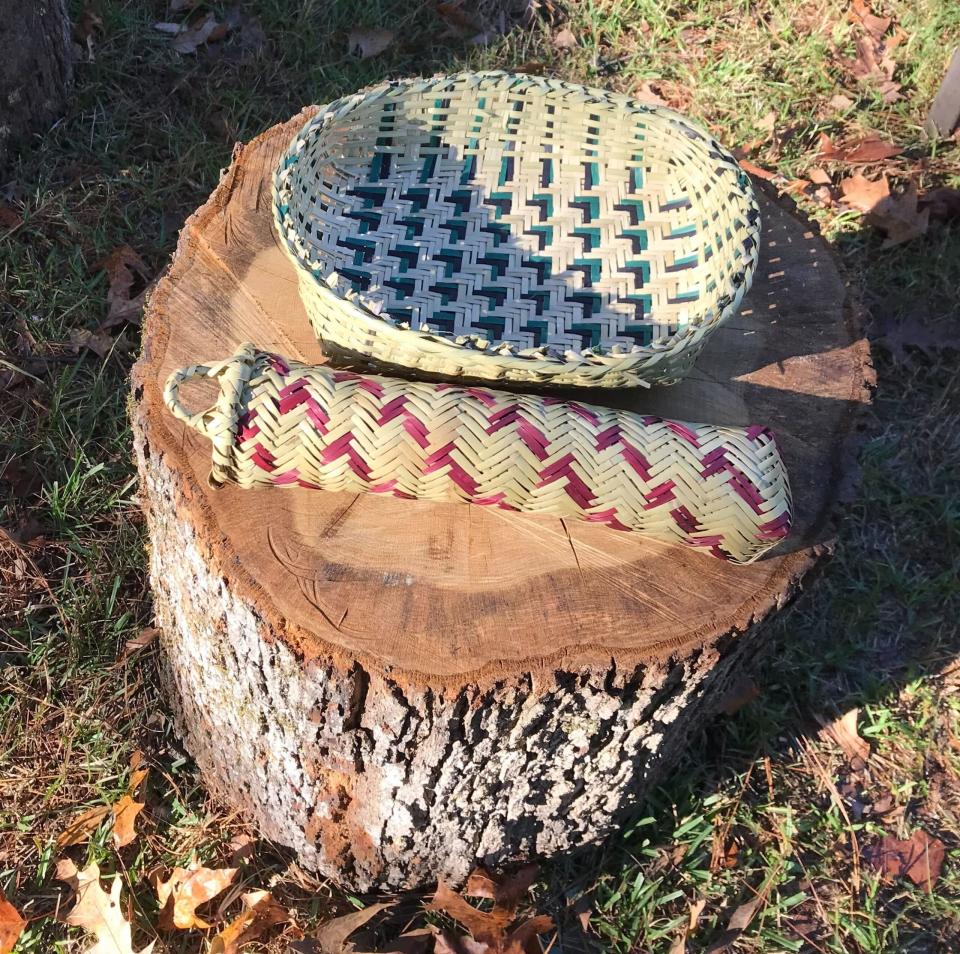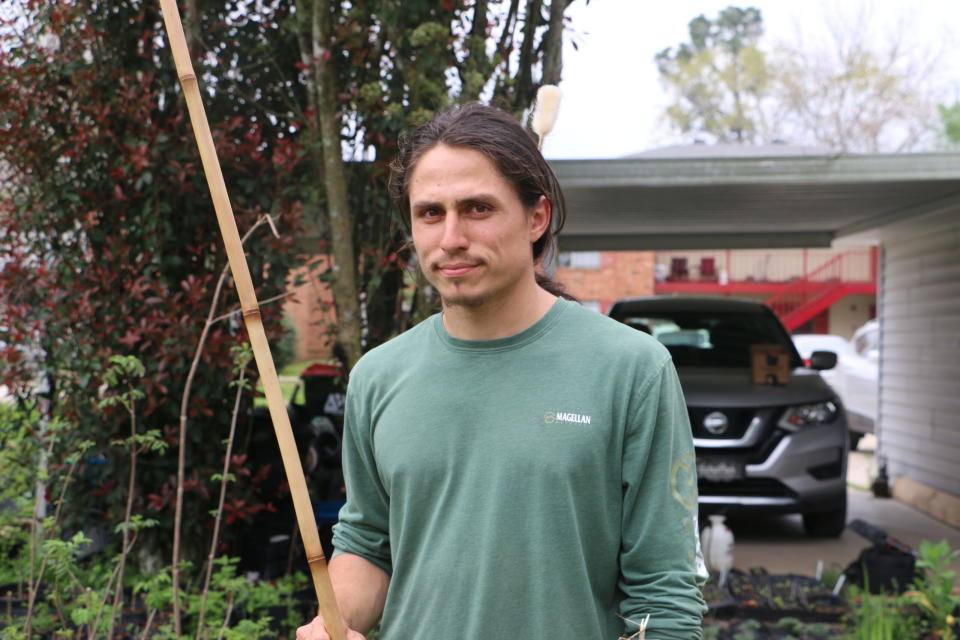Louisiana tribes restore river cane to preserve their culture and the environment

Rose Fisher Greer, one of the only basket weavers left in the Jena Band of Choctaw Indians, holds a piece of river cane in Louisiana’s Kisatchie National Forest on April 17, 2024. (Eva Tesfaye, WWNO)
Rose Fisher Greer and her daughter are the only basket weavers left in the Jena Band of Choctaw Indians, a tribe based in central Louisiana.
To practice her craft, Greer needs river cane. For that, she has to go into Kisatchie National Forest, and she’s the only person in her tribe willing to make the journey. At one patch just off the side of the road, a few feet into the forest, the river cane grows in clusters of green stalks several feet high.
In April, Greer drove out to harvest some, along with David Moore, a U.S. Department of Agriculture Forest Service botanist who works at Kisatchie. “The last basket weaver died in the 1930s from my tribe,” she said. “So that tradition and that part of our culture had died out, you know, fifty, sixty years before I was even born.”
Greer enjoys being a part of the process of making a basket from start to finish. “It’s very meaningful for me to even harvest the cane because I know I’m doing the same thing my ancestors did and my ancestors’ ancestors,” she said.
Listen to this story, which first aired on WWNO-FM.
When she was 15, Greer took a class on basket weaving from a man from southern Louisiana, who had learned from a Choctaw woman.
“I’ve just been doing it ever since, and doing everything in my power and to try to keep this alive in my tribe,” Greer said. “I don’t ever want it to die out again.”
Tribal members and other advocates from across the South, including in Louisiana, Oklahoma and Alabama, are working toward that goal — hoping to sustain their basketry culture and rebuild important native habitats in the process.
GET THE MORNING HEADLINES DELIVERED TO YOUR INBOX

Cane groves are ‘long gone’
Greer cut off a stalk and tapped it with her knife, to see if it was thick enough. Then, after making cuts at the top of the cane, she slammed the stalk into a piece of wood, splitting it into four. When preparing stalks for weaving, she splits those again and again until she has several with the width she wants. She then peels them into strips and shaves them down. It’s a difficult and dangerous process.
“Canes are really sharp. They’re sharp like a razor, and you’re going to cut yourself. That is an absolute fact,” she said.
But the biggest problem is that river cane is so hard to get, even for Greer, who has an agreement with the USDA to harvest it from Kisatchie. The forest is crawling with bugs and animals. Within minutes of stepping into the cane patch, we encountered ticks, mosquitoes and a poisonous copperhead snake.
Many Louisiana tribes pride themselves on their basketry and rely on river cane for it. The species used to be abundant.
“Historically, river cane grew especially in the Mississippi River Valley. Big groves, big cane, thick. You couldn’t hardly get into them. Those are long gone. They’re farmland now,” said Moore, the forest service botanist.

River cane is one of only three bamboos native to North America, but now there is little of it left. The USDA estimates that the country has lost 98% of its river cane habitat since European settlement, a situation that has had cascading environmental impacts. River cane helps improve soil quality, filter water and store carbon.
The Louisiana black bear also uses river cane for cover. Historically, bison would have grazed on it. Now, deer do.
Restoring cane lands close to home
Tribes across the country are helping to restore river cane. Last October, 12 tribes attended the first River Cane Gathering, hosted by the United Keetoowah Band of Cherokee Indians in Oklahoma.
The Chitimacha Tribe of Louisiana started growing its own river cane in 1997. Basketry was critical to the survival of the Chitimacha. At the turn of the 20th century, the tribe raised funds by selling baskets to get back land that had been taken from them.
“Basically every able-bodied woman in the tribe was weaving to make money,” said Kimberly Walden, the tribe’s cultural director and historic preservation officer.
Before they began growing their own patch, the Chitimacha had an agreement with a private landowner to harvest from another property. But the land was far away, and one summer, a miscommunication led to their lives being threatened.
“My first trip to a river cane patch, we were run out at gunpoint,” said Walden.
A USDA conservationist new to the area approached the tribe’s chairman and offered to help. That partnership enabled the tribe to start its own river cane patch on its reservation. Now it’s the most successful river cane restoration project in the state.
“It’s really a game changer because you don’t want to take more cane than you can peel within a few days because it dries out,” said Walden.
One of the tribe’s weavers, Neka Savage, said having the patch nearby means she can weave more baskets for her and her family.
“You’ll see a lot of baskets in museums that have been only made for display,” she said. “To have the baskets be accessible in our homes, that has become my mission to myself and my family.”
A native planting option
It’s not just tribes contributing to the revival of river cane. An hour or so northwest of the Chitimacha reservation, Bruno Sagrera is propagating the plant’s rhizomes on his urban farm. He’s a Choctaw farmer in Abbeville, but not enrolled with a tribe. His elder, who was Cherokee, taught him to craft blowguns using river cane for hunting small game.

“Blowguns were actually one of the main tools traditionally used down here in the Southeast,” he said.
Last October, he decided to learn how to grow river cane so he could give it to others and, he said, “hopefully get the populations back up to where it’s not so critical.”
“Most people have no idea what it is. They’re just like, ‘Oh, that’s just like the bamboo that grows,’ or whatever. Like my family, for example, they’ll just mow over it,” he said.
He said that anyone can help the cause: If you’re considering planting bamboo, try planting river cane instead. If you do grow river cane or come across some on your property, reach out to the nearby tribes and see if they want some.
This story is a product of the Mississippi River Basin Ag & Water Desk, an independent reporting network based at the University of Missouri in partnership with Report for America, with major funding from the Walton Family Foundation. The Louisiana Illuminator is an affiliate of the Ag & Water Desk and Report for America.
The post Louisiana tribes restore river cane to preserve their culture and the environment appeared first on Louisiana Illuminator.

